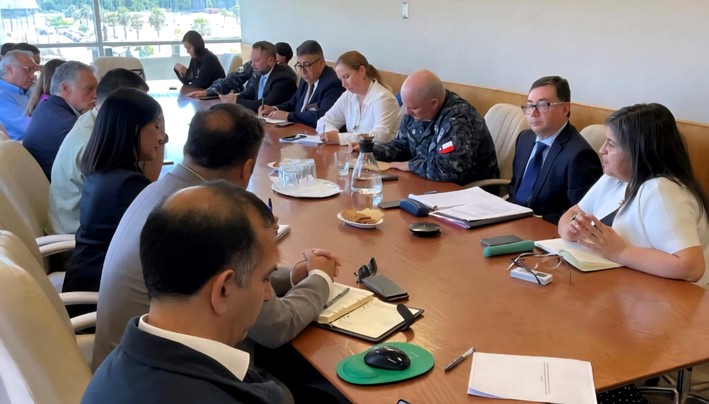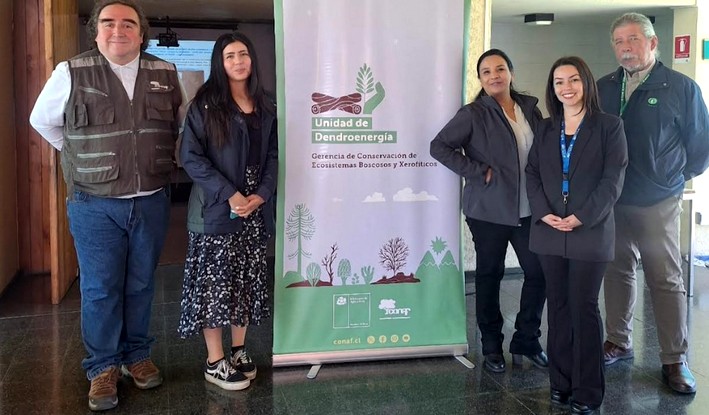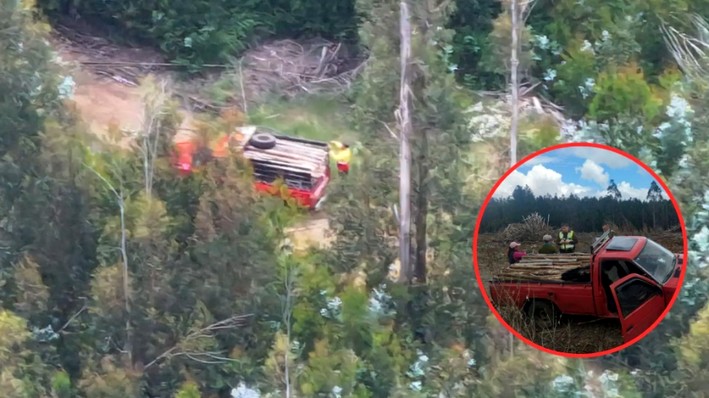Roberto Garrido, Prosecutor: “The groups operating in the Southern Macrozone act no differently than the Tren de Aragua”
One of the crimes that has had the greatest impact in Chile, at least in the past year, was the murder of three police officers—Carlos Cisternas, Sergio Arévalo, and Misael Vidal—on April 27, 2024, in Cañete, in the Biobío region of the Southern Macrozone. Ambushed at night while monitoring the house arrest of a suspect detained for drug and weapons offenses, they were shot dead, and their bodies were later burned inside their institutional pickup truck nearby. Leading the investigation, which resulted in the arrest of the three perpetrators—the last of them, Tomás Antihuen Santi, was captured on Friday the 21st after eight months on the run—is Roberto Garrido (Concepción, 49 years old), the chief prosecutor of the La Araucanía region. It was a complex case: it occurred in darkness, in a rural area with winding roads, there were no direct witnesses, and security cameras were scarce.
Despite these difficulties, Garrido recounts that when the investigation began, he and his team remained “confident” they would make progress. “We knew there would be pressure [for quick results] and likely criticism from political interests of questionable motives, but we were at peace knowing we would detain those responsible,” he says in this interview with EL PAÍS.
In fact, three months after the triple murder, Felipe (29) and Yeferson Antihuen Santi (19), along with Nicolás Rivas Paillao (19), who provided a shotgun, were arrested. The fourth suspect, Tomás Antihuen (25), brother of two of the accused, was found in a house owned by a member of one of the radicalized groups operating in the Southern Macrozone. On Monday, during his formal indictment, the presiding judge, Cristian Rosenberg, stated that the murder “was carried out with a degree of contempt for human life rarely seen.”
Two of the brothers had prior records. Before the triple murder, after a pickup truck robbery, one of their cell phones was found, and when analyzed, it contained an image that caught Garrido’s attention: “It was a search related to martyred police officers,” he recounts. Tomás Antihuen, meanwhile, spent six months in prison in 2020 for throwing Molotov cocktails at a police vehicle with officers inside during a protest in Cañete. The prosecutor recalls that in prison, he went on a hunger strike, claiming to be a “political prisoner.” Even today, graffiti in the area where the officers were killed still portrays him as such.
Question. During the hearing, you said the officers were executed. That’s a very strong word.
Answer. The sequence of events, reconstructed from evidence—such as security cameras capturing the police vehicle at a certain time, witness statements confirming the patrol passed by but never returned—allowed us to narrow down the timeline. The attack was brief. The location of the murders, combined with thanatological analyses of the ballistic trajectories in the victims’ bodies, indicates the officers were in a physically inferior position: either kneeling or lying on the ground when shot.
Q. Had you ever investigated a case like this before?
A. I don’t like comparing cases, but here, there’s an element that defies the norm. I’ve investigated homicides, some extremely brutal, but three victims is unusual. And these were three officers, which is also uncommon. Attacking a police officer carries symbolic weight. In fact, we ruled out that the attack specifically targeted them—it could have been anyone performing those duties that day.
Q. What was the motive? A show of force or stealing the weapons?
A. From my perspective, there was an immediate financial motive: seizing the weapons. This is proven by the weapons recovered near the crime scene. Tomás Antihuen not only had one officer’s gun but used it to shoot them. Considering the brothers typically committed crimes requiring firearms, ammunition, and bulletproof vests—items the officers carried—there was clear immediate gain. The date of the attack (Police Anniversary), moving the bodies in the pickup truck, setting it ablaze, and firing at it again was a show of force. The symbolism lies in the violent message of defiance against the state and instilling fear in society.
Q. For a long time, people spoke of rural violence in the Southern Macrozone. Is that term still valid?
A. For a while, we used “rural violence” to describe crimes linked to rights activism. But the term became outdated—it no longer reflected reality in La Araucanía and other southern regions. A key step was redefining this phenomenon for what it truly is: criminality operating in rural areas, masked by political slogans but devoid of political purpose.
Q. What have you observed?
A. These are organized groups with stable operations and funding from common crimes: vehicle thefts, marijuana cultivation and trafficking, large-scale timber theft using forestry machinery, and extortion. Arrests, increasing since 2020, revealed their claims of being “political prisoners.” Even Mapuche community members have been murdered—like Freddy Marileo, imprisoned for killing two Mapuche villagers, who claimed persecution for being Mapuche. This rhetoric exposes these groups’ true nature. Violence peaked in 2021 but has since declined, making the officers’ murder an outlier that stands out.
Q. You describe theft, drug trafficking, weapons, extortion. Once, you compared Southern Macrozone groups to the Tren de Aragua. Can you explain?
A. In 2021, one of La Araucanía’s most violent incidents was the kidnapping of two people in Collipulli, allegedly over stolen marijuana. One escaped; the other was murdered, dismembered, dissolved in acid, burned, and dumped in a river. This shocked the country, but later, equally brutal cases emerged in northern Chile. The groups in the Southern Macrozone operate no differently than other criminal organizations, like the Tren de Aragua. The clearest parallel is their goal: territorial control. Whether in the south or north, their aim is to expel the state. This explains attacks on public infrastructure—like burning schools—to dominate areas, extort money, commit crimes, and claim control under false pretenses.
Q. Was it hard to convince the public this was organized crime?
A. The shift wasn’t driven by us. Our job is to present evidence in court about these groups’ crimes and structure. Over time, the public recognized these aren’t romanticized movements benefiting communities—they enrich themselves or their leaders. Attacking utility vehicles repairing roads has no ties to rights activism. Nor are these violent protests, as some once claimed. Their victims aren’t large forestry firms but small business owners losing everything. Once these groups gained territorial control, instead of restoring “usurped” lands to communities, they exploited them for logging.
Source:El País

















